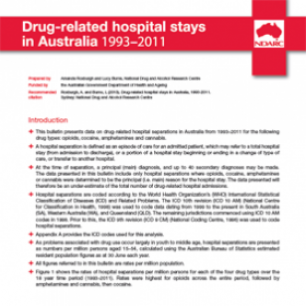- This bulletin presents data on drug-related hospital separations in Australia from 1993–2011 for the following drug types: opioids, cocaine, amphetamines and cannabis.
- A hospital separation is defined as an episode of care for an admitted patient, which may refer to a total hospital stay (from admission to discharge), or a portion of a hospital stay beginning or ending in a change of type of care, or transfer to another hospital.
- At the time of separation, a principal (main) diagnosis, and up to 40 secondary diagnoses may be made. The data presented in this bulletin include only hospital separations where opioids, cocaine, amphetamines or cannabis were determined to be the principal (i.e. main) reason for the hospital stay. The data presented will therefore be an under-estimate of the total number of drug-related hospital admissions.
- Hospital separations are coded according to the World Health Organization’s (WHO) International Statistical Classification of Diseases (ICD) and Related Problems. The ICD 10th revision (ICD 10 AM) (National Centre for Classification in Health, 1998) was used to code data dating from 1999 to the present in South Australia (SA), Western Australia (WA), and Queensland (QLD). The remaining jurisdictions commenced using ICD 10 AM codes in 1998. Prior to this, the ICD 9th revision (ICD 9 CM) (National Coding Centre, 1996) was used to code hospital separations.
- Appendix A provides the ICD codes used for this analysis.
- As problems associated with drug use occur largely in youth to middle age, hospital separations are presented as numbers per million persons aged 15–54, calculated using the Australian Bureau of Statistics estimated resident population figures as at 30 June each year.
- All figures referred to in this bulletin are rates per million population.
- Figure 1 shows the rates of hospital separations per million persons for each of the four drug types over the 18 year time period (1993–2011). Rates were highest for opioids across the entire period, followed by amphetamines and cannabis, then cocaine.
Drug-related hospital stays in Australia 1993-2011

Resource Type: National Illicit Drug Indicatiors Project (NIDIP) Bulletins

